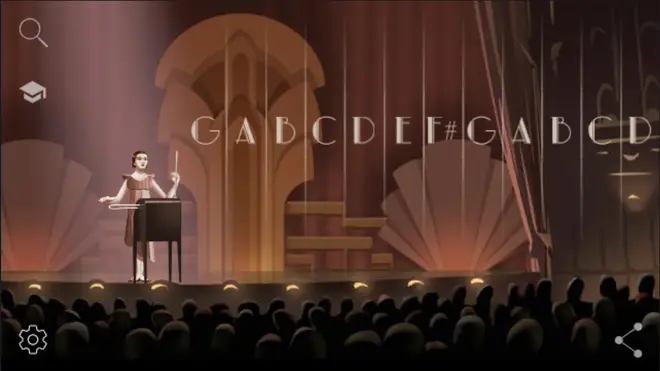On Air Now
Classic FM Breakfast with Dan Walker 6:30am - 9am
30 April 2020, 16:52 | Updated: 20 June 2022, 11:39

Google's Doodle celebrates Clara Rockmore playing the Theremin
Teach yourself the world’s eeriest instrument in the company of a pro.
Today’s Google Doodle lets you play the theremin with virtuoso Clara Rockmore.
The interactive virtual experience, which celebrated the 105th anniversary of the birth of theremin virtuoso and all-round legend Clara Rockmore when it first launched in 2016, allows you to “play” the instrument with your mouse, producing pitches in selected scales – and octaves – that can be changed easily in the “settings” cog.
If you want to have a go, click the Google logo, and press the play arrow and you enter Lesson 1. The wonderful Clara Rockmore herself, in Doodle form, proceeds to teach you the first note (Lesson 1), then the next couple of notes (Lesson 2), and then a few more notes (Lesson 3) of ‘The Swan’ from Saint-Saëns’ Carnival of the Animals.
Doodle Rockmore then gives us the treat of a little rendition of the complete first phrase of the piece. And after that, you’re free to “Now enjoy playing the theremin”.
Read more: Watch Lady Gaga’s attempt to play the theremin >

In the aforementioned settings cog, you can also turn off “Easy Mode” and the names of the notes disappear. You can also change key and choose the type of scale. All in the company of the lovely Clara, who stands and plays on the left-hand side. It’s really sweet.
Google is giving the 2016 game a re-run today as part of its initiative to celebrate its most popular interactive Doodles to help combat lockdown boredom.
“As COVID-19 continues to impact communities around the world, people and families everywhere are spending more time at home,” Google says. “In light of this, we’re launching a throwback Doodle series looking back at some of our popular interactive Google Doodle games!”
Click here for the latest coronavirus advice from the NHS >
We know what we’re going to be doing all day...

'Ode to Joy', played by Matryomin Ensemble on THEREMINS
Clara Rockmore “made music from thin air”, to quote the chaps at Google. She was a Russian-American violin prodigy, who at the age of four became the youngest student to ever enrol at the St. Petersburg Conservatory. In 1921, when the family emigrated to America, she enrolled at the Curtis Institute of Music.
Tendonitis in her bow arm started to affect her violin playing, and that’s where the theremin came in. She met Léon Theremin, the inventor of the instrument, and worked with him on learning and refining the instrument (she convinced Theremin that it should be made more responsive and offer a five-octave range of notes instead of three), becoming its most prolific player and advocate early on.
She toured extensively with orchestras playing the instrument and released a commercial recording called The Art of the Theremin. The album was produced by Bob Moog and Shirleigh Moog (Bob Moog being Robert Moog, the inventor of Moog synthesiser).
In 2016, Google marked the 105th anniversary of Rockmore’s birth with the virtual theremin Google Doodle, created by artist Robinson Wood, interaction designer Kevin Burke, and engineers Will Knowles and Kris Hom, and re-released it on Thursday 30 April for coronavirus lockdown.

Man shows intricacies of playing the theremin with this beautiful performance
The theremin, invented by Léon Theremin, ushered in one of the very first times electronics were used specifically to create music.
The instrument works by amplifying an electric current, which produces sound when it is interrupted by a player’s hands. The frequency is altered by the addition and movement of the player’s hands between two antennas, making it the only instrument that uses no contact to play.
It produces an eerie sound and as such has been used prolifically in science fiction film soundtracks, including for Miklós Rózsa’s Spellbound and The Lost Weekend, and Bernard Herrmann’s The Day the Earth Stood Still.